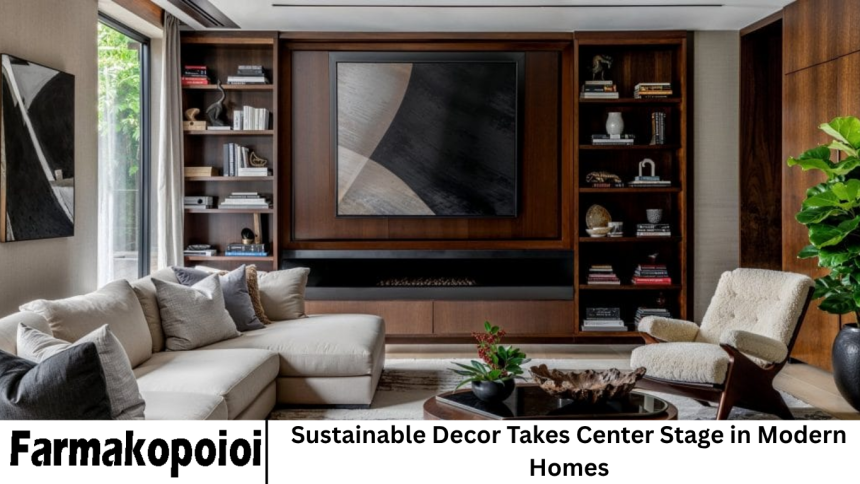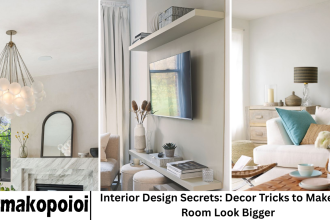In the evolving world of interior design, one trend has risen above all others—sustainability. Homeowners today are not only concerned with how their spaces look, but also with how they impact the planet. The concept of sustainable decor has shifted from being a niche interest to a mainstream movement.
- The Rise of Sustainable Homes Decor
- Principles of Sustainable Decor
- Resource Efficiency
- Reuse and Recycle
- Local Sourcing
- Durability and Longevity
- Eco-Friendly Materials
- Minimalism and Mindfulness
- Materials That Define Sustainable Design
- Trends Driving Sustainable Decor in 2025
- Circular Design
- Vintage Revival
- Natural Color Palettes
- Biophilic Design
- Smart Sustainability
- Handcrafted and Artisan Goods
- Multi-Functional Furniture
- How to Create a Sustainable Home
- Start Small
- Buy Second-Hand
- Support Ethical Brands
- Choose Energy-Efficient Appliances
- Use Plants as Decor
- DIY and Upcycle
- Go Minimalist
- The Psychological Benefits of Sustainable Living
- The Economic Value of Sustainability
- The Role of Designers and Brands
- The Future of Sustainable Home Design
- Frequently Asked Question
- Conclusion
From reclaimed wood furniture and organic fabrics to energy-efficient lighting and recycled materials, eco-conscious design is redefining what it means to live beautifully. Sustainability in decor isn’t about sacrificing style—it’s about blending aesthetics with ethics.
In this article, we’ll explore the rise of sustainable home decor, the principles behind it, the latest trends, materials, and design innovations, and how you can embrace this planet-positive movement in your own living space.
More Read: Australia Unveils Its First Multi-Story 3D-Printed Home, Completed in Only 5 Months
The Rise of Sustainable Homes Decor
Over the last decade, the global conversation around climate change, waste reduction, and conscious consumption has dramatically reshaped industries—and interior design is no exception. Consumers have grown increasingly aware of the environmental consequences of fast furniture, synthetic materials, and disposable decor.
This awareness has led to a powerful shift toward sustainability-driven living spaces. People are now more interested in products made with minimal environmental impact, whether that means using non-toxic paints, recycled textiles, or responsibly sourced wood.
A 2024 global interior design survey revealed that over 68% of homeowners consider sustainability a top priority when redecorating or remodeling their homes. Millennials and Gen Z, in particular, are driving this shift—favoring brands that align with their environmental values.
But sustainability isn’t just about materials. It’s also about mindful design practices—buying less, choosing quality over quantity, and investing in items that stand the test of time.
Principles of Sustainable Decor
To truly understand this movement, it’s important to look at the core principles that guide sustainable decor:
Resource Efficiency
Sustainable design aims to use resources wisely—whether that’s reducing water usage, conserving energy, or minimizing waste during production. Efficient manufacturing processes and energy-saving home systems (like LED lighting or smart thermostats) help lower the environmental footprint.
Reuse and Recycle
Instead of throwing things away, sustainable homes emphasize reuse and upcycling. Vintage furniture, reclaimed wood, and repurposed materials are all examples of how items can be given new life without creating additional waste.
Local Sourcing
Buying locally reduces transportation emissions and supports regional artisans and businesses. Handcrafted decor items made within your community often have lower carbon footprints compared to imported, mass-produced products.
Durability and Longevity
Fast decor trends encourage frequent replacements, but sustainable design values timelessness and durability. The focus is on quality craftsmanship and materials that will last for decades.
Eco-Friendly Materials
Non-toxic paints, organic cotton, bamboo, cork, hemp, and recycled metals are just a few materials that embody sustainability. These choices promote healthy indoor air quality and minimize pollution.
Minimalism and Mindfulness
Sustainability aligns closely with minimalism—the idea of having fewer, more meaningful possessions. Every decor choice becomes intentional, contributing to both aesthetics and well-being.
Materials That Define Sustainable Design
The heart of sustainable decor lies in the materials used. These materials not only shape the look of a home but also determine its environmental impact.
Reclaimed Wood
Using reclaimed or salvaged wood from old buildings, barns, or furniture reduces the need for new timber. Each piece tells a story, adding warmth and history to interiors.
Bamboo
Bamboo is a fast-growing, renewable resource that’s durable, versatile, and stylish. From flooring to blinds and furniture, it’s one of the most popular eco-friendly materials in modern design.
Recycled Metals and Glass
Metals like aluminum and steel can be recycled infinitely without losing strength, while recycled glass adds a touch of color and texture to decor items like vases or countertops.
Organic Textiles
Fabrics such as organic cotton, hemp, jute, and linen are produced without harmful chemicals, making them ideal for upholstery, bedding, and curtains.
Cork
Harvested from cork oak trees without damaging them, cork is renewable, biodegradable, and provides excellent insulation.
Eco Paints and Finishes
Low-VOC (volatile organic compound) or VOC-free paints significantly improve indoor air quality and reduce toxic emissions.
Trends Driving Sustainable Decor in 2025
As eco-consciousness becomes mainstream, designers are finding innovative ways to merge sustainability with luxury and creativity. Here are the top sustainable decor trends shaping 2025:
Circular Design
Circular design focuses on creating products that can be reused, repaired, or recycled at the end of their life cycle. Brands are moving away from “use and discard” models and embracing longevity.
Vintage Revival
Thrift shopping, antique markets, and furniture restoration have become fashionable again. The “buy vintage, not new” movement is both environmentally responsible and aesthetically unique.
Natural Color Palettes
Earth tones—beige, terracotta, olive green, and sand—dominate modern interiors. These hues evoke calmness and connect homeowners to nature.
Biophilic Design
Biophilic design integrates nature into living spaces through indoor plants, natural light, water features, and organic shapes. Studies show it improves mental health and well-being.
Smart Sustainability
Technology is playing a big role in sustainability. Smart home systems help monitor energy usage, reduce waste, and optimize temperature and lighting efficiency.
Handcrafted and Artisan Goods
People are moving away from mass-produced items and supporting local artisans. Handmade pottery, woven baskets, and custom wooden furniture bring character and authenticity to homes.
Multi-Functional Furniture
Compact urban living has led to the rise of multi-purpose furniture—like extendable tables, modular sofas, and storage-integrated beds—that reduce clutter and encourage minimalism.
How to Create a Sustainable Home
Transitioning to sustainable decor doesn’t have to happen overnight. Here’s how you can gradually transform your home into an eco-friendly sanctuary:
Start Small
Begin by replacing single-use or synthetic items with sustainable alternatives. For instance, switch plastic storage containers with glass, or buy LED bulbs instead of incandescent ones.
Buy Second-Hand
Explore thrift stores, estate sales, or online marketplaces for unique vintage finds. You’ll save money while reducing demand for new production.
Support Ethical Brands
Look for furniture and decor brands that prioritize sustainability, fair labor, and transparency. Certifications like FSC (Forest Stewardship Council) or Global Organic Textile Standard (GOTS) ensure responsible sourcing.
Choose Energy-Efficient Appliances
Energy-efficient lighting, low-flow fixtures, and eco-certified appliances lower your carbon footprint and energy bills.
Use Plants as Decor
Indoor plants purify the air, regulate humidity, and enhance the ambiance. Choose low-maintenance species like pothos, snake plants, or peace lilies.
DIY and Upcycle
Get creative by repurposing old furniture or decor items. A coat of eco-friendly paint or new upholstery can give an old chair or table a fresh, modern life.
Go Minimalist
Decluttering and embracing simplicity reduce waste and consumption. The less you buy, the less you throw away.
The Psychological Benefits of Sustainable Living
Beyond environmental advantages, sustainable living also offers emotional and psychological benefits. Research shows that living in eco-friendly spaces can lead to:
- Improved mental well-being: Natural materials and greenery reduce stress and promote relaxation.
- Better air quality: Low-VOC paints and organic fabrics decrease indoor toxins.
- Increased mindfulness: Conscious decorating fosters appreciation and intentional living.
- A sense of purpose: Knowing your lifestyle supports environmental health brings fulfillment and pride.
A sustainable home isn’t just good for the planet—it’s good for your soul.
The Economic Value of Sustainability
Contrary to the belief that eco-friendly living is costly, sustainable choices often save money over time. Energy-efficient appliances lower bills, durable materials reduce replacement costs, and second-hand furniture is usually cheaper than new items.
Additionally, as green building standards rise, sustainable homes are fetching higher resale values. A 2024 property report revealed that eco-certified homes sell for up to 9% more than conventional ones. Buyers are increasingly drawn to homes that are energy-efficient and designed responsibly.
Sustainability isn’t just an ethical choice—it’s a smart financial investment.
The Role of Designers and Brands
Interior designers and brands play a critical role in advancing sustainability. Many leading names in the industry have launched eco-conscious collections and adopted responsible production practices.
For instance:
- IKEA now uses renewable energy in manufacturing and designs products for recyclability.
- West Elm sources FSC-certified wood and partners with Fair Trade artisans.
- Patagonia Home repurposes recycled fabrics from its apparel line for home textiles.
Designers are also prioritizing materials that are locally sourced, biodegradable, or modular. This shift is redefining what “luxury” means—luxury is now about craftsmanship, conscience, and connection.
The Future of Sustainable Home Design
The future of home decor is unmistakably green. As technology, awareness, and innovation converge, sustainable design will continue to expand and evolve.
Future trends may include:
- 3D-printed furniture made from recycled plastic or plant-based polymers.
- Carbon-neutral homes powered entirely by renewable energy.
- Smart waste systems that automatically compost organic waste.
- Closed-loop production where decor items are endlessly recyclable.
The goal is not just to decorate homes, but to design ecosystems that nurture both people and the planet.
Frequently Asked Question
What exactly is sustainable home decor?
Sustainable home decor refers to designing and furnishing homes using environmentally friendly materials, ethical production methods, and energy-efficient solutions that minimize harm to the planet.
Is sustainable decor more expensive than traditional options?
While some eco-friendly materials may have higher upfront costs, they often save money in the long run due to their durability, energy efficiency, and timeless appeal.
How can I make my home more sustainable without a full renovation?
Start with small changes like using LED lighting, adding houseplants, choosing organic textiles, or buying second-hand furniture instead of new mass-produced items.
What are some eco-friendly materials I can use in my home?
Popular materials include bamboo, reclaimed wood, cork, organic cotton, hemp, recycled metals, and low-VOC paints—all of which are renewable and non-toxic.
How does sustainable decor benefit my health?
Sustainable materials improve indoor air quality by eliminating toxic chemicals and promoting natural ventilation, leading to fewer allergies and better well-being.
Are sustainable homes more energy-efficient?
Yes. Sustainable homes often use energy-efficient lighting, insulation, and appliances that reduce both carbon emissions and utility costs.
What’s the future of sustainable interior design?
The future will see increased use of smart technologies, renewable materials, circular design models, and carbon-neutral construction—creating homes that are self-sustaining and eco-positive.
Conclusion
Sustainable decor is more than just a design choice—it’s a movement toward conscious living. By embracing eco-friendly practices, we’re shaping homes that reflect care, integrity, and foresight. Every decision—from the paint we choose to the furniture we buy—can make a difference.
Modern homes are evolving into reflections of sustainability, where style meets substance and beauty meets responsibility. The era of disposable decor is fading, and in its place stands a new generation of thoughtful, enduring, and planet-positive design.






















